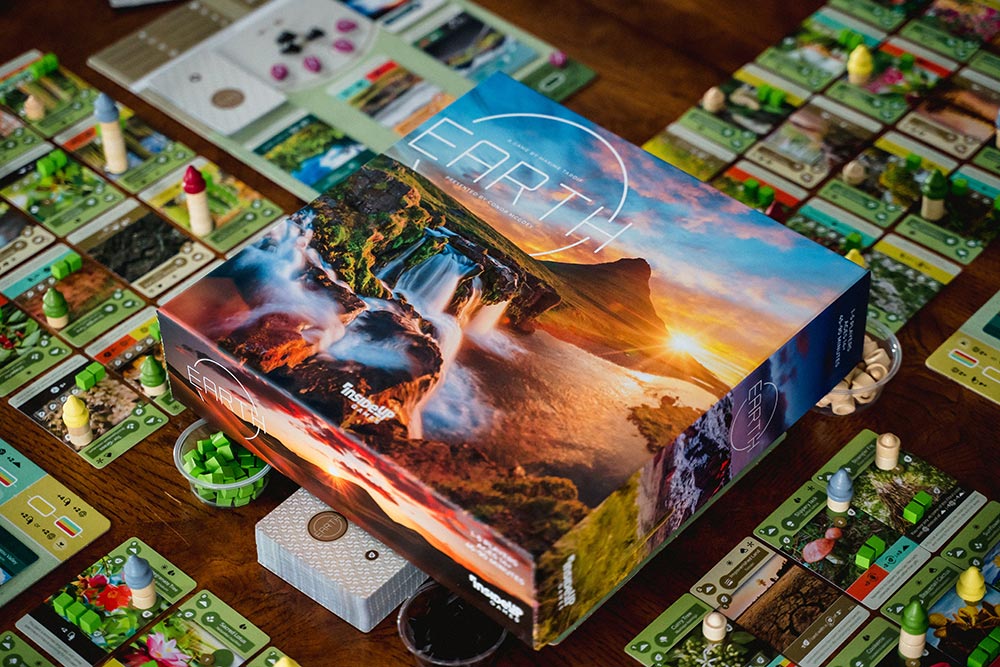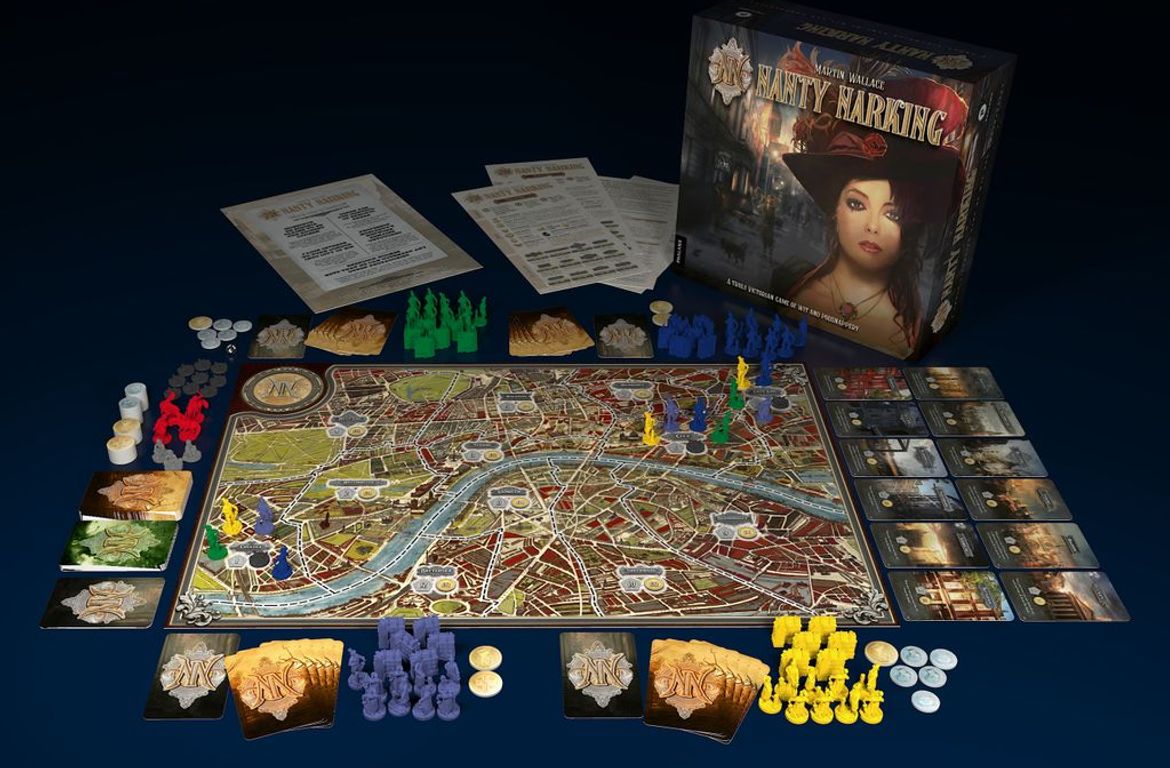
Earth: Istražite Prirodna Čuda planete Zemlje kroz Društvenu Igru
U svijetu društvenih igara, Earth se ističe kao igra koja kombinira ekološku svjesnost, strategiju i prekrasnu umjetnost. Ako ste ljubitelj
Hi, I’m Donald Shults, the designer of Plaid Hat Games‘ Freelancers: A Crossroads Game.
When designing a large, narrative game like this, especially one intended to capture the vibe of an entire genre (fantasy RPGs), there are a lot of ideas you come up with, try out, then reject before thinking up a different approach. I thought it might be interesting to share some of how that design and development process works…mostly because Reiner Knizia keeps texting me to ask for tips, but also in an effort to highlight a few of the contributions our developers made.
Sidequests
The game uses a location book in which each double-page spread depicts a setting or event on the left page and seven action spaces on the right. From the start of the project, I had this idea that each right-hand page could have an eighth space on it, a new space type that could hold up to three players. These spaces were called “Sidequests” and featured three spots for player standees, but more importantly they featured a space for a card to their right. The card would nest into the graphic design of the page.
This would create a context sensitive quest that would theoretically be different every time you played. In this special space, a player who went there would have the opportunity to recruit two other players to go on a side quest.
However, players were still free to go to that space on their own at the top of the round. Looking at the numbers of the cards and how the page changed them and which elements were strong was supposed to let players make fun and informed decisions about who would be best to help, but anyone could elbow their way in for the chance at a reward.
The idea was basically to create the feeling in an RPG when players with specific skills get recognized for them and get a chance to shine when they use them. I wanted a moment when you would ask, “We need someone who can translate these runes! Susan, your character is smart. Will you do it?”
This possibility felt essential to the TTRPG vibe I was trying to capture, and one of the things that dungeon crawlers often exclude.
I whipped up a few side quests, and in early playtests they were really well received, but the overall execution was confusing. Players had more questions about side quests and how they worked than about any other mechanism in the game.
Players liked the multi-step narrative spaces, but determining how to select the action and when it was a smart play was confusing and convoluted. I fought for the idea for far too long, refashioning and rethinking small details over and over. Each iteration got further from what I was originally trying to accomplish.
Eventually, though, I had a long talk with developer Joseph Arthur Ellis about alternative ways to do this. The immediate solution was having a multi-step card that players would go to when they took the side quest option. This would give players on over-arching side quest that they could chip away at through their adventure — but the reality was beginning to set in that the game was already huge and this would represent either a ton of writing or a lot of vanilla skill checks with no meaningful decisions.
Around this time, I was also beginning to worry that the game needed more dungeon crawling. For each adventure to feel like a full campaign, we’d need some zones that were less consequential to the plot momentum and more about exploring and dungeon crawling.
This lead to a pretty obvious eureka moment in which I added “dungeons” to the map and used the exact same mechanism that Joseph had proposed for side quests. These dungeons tend to be all-or-nothing chances for several players to earn a reward together. They also provide a chance for everyone to self-select players who haven’t had as many opportunities to participate and skirt the influence system a bit.
Overall, the current system is one of my favorite design spaces in the game and something I’m super proud of, but I wouldn’t have gotten there without rethinking my initial core idea I had for the game.
Burdens
One of the major design goals of Freelancers was to find a middle ground between how crossroads worked in Forgotten Waters and Dead of Winter. From the start, I had crossroad spaces on the maps, and going to those spaces would lead to crossroad moments. That idea evolved and got better through development and eventually used the app to reach its potential.
It wasn’t enough for me, though. As Freelancers was coming together, I was still searching for ways to work in a physical crossroad card that felt exciting and additive to the experience. I was really hung up on this idea — and admittedly still am — but my proposed solution, Burdens, just didn’t come together.
Burdens were cards you could receive as a negative effect that put a hard stop on progression for certain skills until another player did something to help you. This concept had multiple revisions, with my buddy Jerry Hawthorne even writing some temp narrative text for them and making them look nice.
Jerry works a lot faster than me and also makes much better-looking and more functional prototypes. He was a great asset to have access to.
One side of the card would state which skill you could no longer gain, along with reminder text for how the player to your left could trigger and get rid of that card. When the card was triggered, you would flip it over and read a crossroad event for that player.
Playtesting revealed that it was too punishing to limit progression in a game this short, and also that the player to your left often didn’t have enough time or information to make choosing to get rid of a burden interesting. Burdens just created bookkeeping and added more cards to the game, which already had plenty of fiddly cards as it was.
I was sad to cut Burdens from Freelancers and disappointed that it ate up a lot of time, but remaining agile and flexible with the design was important to me. In the past, I’ve had creative projects that suffered because I “locked in” too many creative ideas too soon.
I will definitely try this idea again in a future game as I think the core idea is still interesting. It just didn’t make sense in this one.
Focus
In early versions of Freelancers, followers went to a “Camp/Influence” board in the middle of the table. Whenever characters took an option, they could also place a focus token on a follower and gain their ability, but they could focus only on a follower who was lower than them on the influence track.
A player could always choose the “rest” option and get a camp action if they didn’t like any of their options on the location page. This would shuffle the followers and reset everyone’s focus.
All of this was a lot of “clever” ideas that each felt good on their own, but combined it moved too much of the game onto a side system. Players would consistently forget it existed, and it required a ton of forethought to take advantage of your followers and focus. This made Freelancers feel slow because it required us to lose the timer and with it, the party game feel of Forgotten Waters. I wasn’t into that, so something had to change.
A long brainstorm session with my friend Sean McCoy helped me narrow down what I wanted from RPG followers in a silly game like this. A lot of ideas got suggested and moved around, and I eventually landed on moving camping to the map (just like dungeons) and making the followers behave more like treasure cards. Their functions were more specific to helping friends and interacting with one another.
Time
Fairly late in the design process, Joseph Ellis and I were feeling pretty good about the various systems that drove the game. Two tracks would slowly increase based on the types of spaces you visited, with other ways to lower them.
However, in a playtest with Nick Conley, Plaid Hat’s genius developer who keeps our card games from sucking, he very politely informed me that moving around the map was annoying and boring.
Obviously, it was tough to hear, but it also struck me as true. Deep down I agreed. I was so thankful for the feedback! It’s very very very hard to get people to engage with your game honestly in playtesting.
In a frantic scramble, Joe and I brainstormed ideas back and forth and landed on the time bag. Putting tokens in a bag to create a simple press-your-luck aspect — inspired by a game of Quacks and Co. we had played with our kids — and simplify the math that was required to move around.
I took that idea home and completely reworked the core mechanisms of the game. Soon followers, supplies, and even wounds were going into the time bag. Decisions were often easier to grok because it was much more clear what will and will not take time from a narrative perspective.
The followers going into the bag required a lot of rethinking with Kendall Elmen, our graphic designer, and Joseph Ellis of how the app would work. It also required committing to a lot of additional writing from Mr Bistro, our staff writer, because now each follower would have several context-sensitive encounters.
Like the rest of the game, it was a team effort, and in the end I’m very happy with how it came together. Like anything, there will always be aspects of Freelancers that bother me, and I plan on using that as inspiration for future projects. As long as I have smart friends and co-workers to steal from, I’m certain that I can spin those ideas into gold and become a household name in board games.
Hope that helps Reiner. Please stop texting.
P.S. Joking aside, I just started playing Ra in 2023. It rocks. The best game. Please be my new dad.

U svijetu društvenih igara, Earth se ističe kao igra koja kombinira ekološku svjesnost, strategiju i prekrasnu umjetnost. Ako ste ljubitelj

U svijetu društvenih igara, rijetko koja igra uspijeva obuhvatiti bogatstvo povijesti, strategije i priče poput Nanty Narkinga. Ova igra, smještena